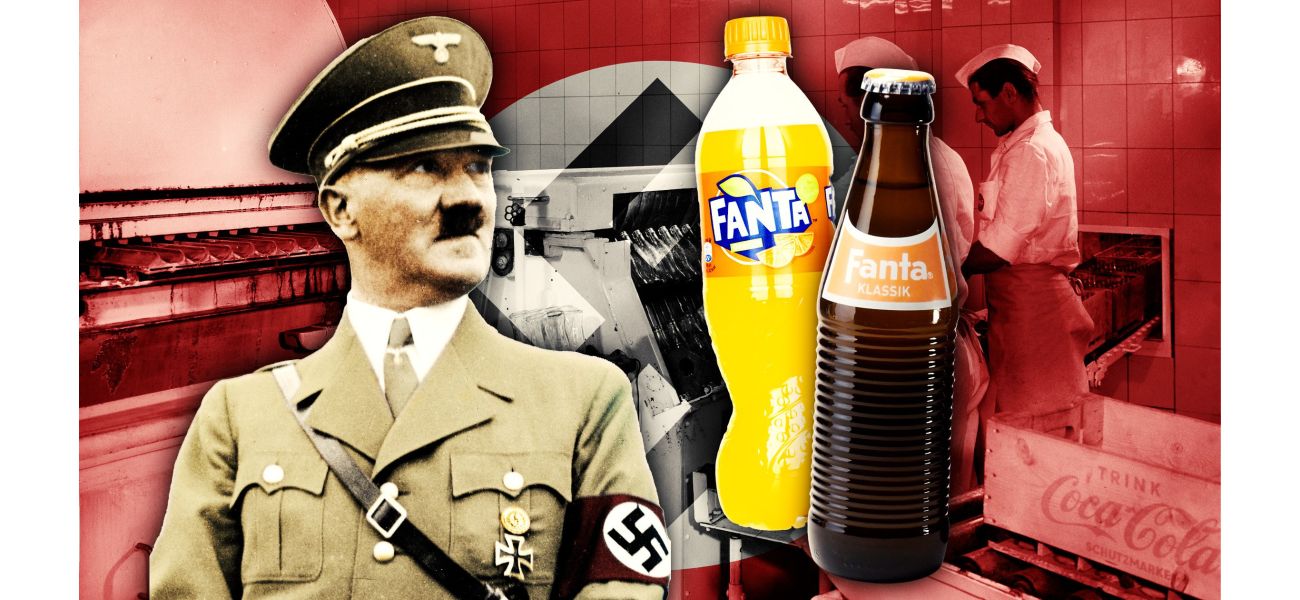Learn about how the Nazis played a role in the creation of a famous beverage.
It was created using leftover ingredients such as fruit pulp and apple fibers.
November 21st 2024.

During the tumultuous times of the early 1940s, a new drink was born in Nazi Germany. As the war raged on, factories and farmhouses were filled with the sounds of machines whirring and bottles clinking. It was here that Fanta was created, a concoction of apple seeds, stems, and skin mixed with a watery liquid left behind from curdled milk.
It's hard to believe, but this strange mixture would eventually become one of the most beloved drinks in the UK. According to YouGov, Fanta ranks as the 7th most famous drink in the country, with other popular drinks such as Robinsons, Ribena, and PG Tips taking the top spots. Over the years, special editions of Fanta have graced supermarket shelves, including flavors like Blood Orange, 'Haunted' Apple, and even a Peri-Peri sauce variety.
But while many of us can easily recognize a Fanta in a lineup of soft drinks, not everyone knows the controversial story behind its creation in 1940. At the time, Coca-Cola ingredients were no longer being sent from the USA to Germany due to the war. This presented a challenge for German businessman Max Keith, who was in charge of Coca-Cola Deutschland. In order to keep the company afloat, he came up with the idea for Fanta.
Prior to the war, Coca-Cola had become incredibly popular in Germany, with sales skyrocketing from 100,000 crates per year to 4.5 million between 1933 and 1939. However, with the introduction of a 'self-sufficiency regime' by Adolf Hitler, Keith had to find a way to convince the Nazi leader to let Coca-Cola Deutschland continue operating, despite its American origins.
Author Mark Pendergrast, who wrote the book For God, Country, and Coca-Cola, explains that Keith was devoted to the company and did whatever it took to keep it going. This included collaborating with the Nazis, although he never joined the party. Keith even provided extra rationed Coca-Cola to the military and displayed swastikas alongside the Coke logo at conventions. He also sported a "Hitleresque" mustache.
During this time, Coca-Cola became closely associated with the Nazi regime. Branded trucks were seen at Hitler Youth marches, and the drink was often served at government meetings. It's even been reported that Hitler himself enjoyed a Coca-Cola while watching Gone With the Wind in his private cinema.
In 1939, Keith threw a 10th birthday party for Coca-Cola Deutschland, which also served as a Sieg-Heil (Nazi Salute) for Hitler. He stated that he wanted to "commemorate our deepest admiration for our Fuhrer." However, Keith's former colleague Klaus Putter explained that he was a cautious man in a country governed by a dictatorship, where even a single wrong remark could be fatal.
But everything changed for Coca-Cola Deutschland in 1941 when the US entered the war after the surprise attack on Pearl Harbor by Japan. As a result, the Trading with the Enemy Act was introduced, and supplies of Coca-Cola syrup were cut off from Germany. Left with only leftovers of leftovers, Keith had to get creative. He used beet sugar to sweeten the drink and put ex-convicts and prisoners of war to work in makeshift factories to produce Fanta.
Although it didn't taste like Coca-Cola, Fanta became a popular drink in Germany. Some people even used it as a sweetener in their meals to avoid the wartime sugar tax. And when supplies to make Coca-Cola ran out in 1942, Fanta kept the Coca-Cola Deutschland franchise afloat until 1945.
Today, Fanta has evolved into a variety of flavors and is enjoyed all over the world. But the origins of this iconic drink are a reminder of the tumultuous times in which it was created and the challenges faced by those who were just trying to keep their business afloat.
In the midst of the chaos and destruction of World War II, a new drink emerged in Nazi Germany. As the country was gripped by war, factories and farmhouses were bustling with the sound of machines and clinking bottles. This was the birthplace of Fanta, a drink that we now know and love in the UK.
But how did this iconic drink come to be? Well, it all started with a shortage of Coca Cola ingredients being sent from the USA to Germany. This forced Max Keith, the head of Coca-Cola Deutschland, to get creative and come up with a new drink using whatever ingredients he could find. And so, a strange concoction of apple seeds, stems, and skin mixed with a watery liquid from curdled milk was poured into massive vats to create the first version of Fanta.
Today, Fanta is a household name in the UK, ranking as the 7th most famous drink according to YouGov. But back in the 1940s, it was a different story. In fact, the top three spots were claimed by Robinsons, Ribena, and PG Tips, with Coca-Cola coming in at 13th place. However, Fanta has always managed to stay relevant with special editions like Blood Orange, 'Haunted' Apple, and even a Peri-Peri sauce variety gracing supermarket shelves over the years.
But while most people can easily pick out a Fanta from a line-up of soft drinks, not many know the controversial story behind its creation. In fact, it all started with Coca-Cola's popularity in Nazi Germany after Adolf Hitler came into power in 1933. Max Keith, a German businessman, was in charge of Coca-Cola Deutschland and was devoted to the company. The brown fizzy drink became a hit in the lead-up to the war, with sales skyrocketing from 100,000 crates to 4.5 million per year between 1933 and 1939.
However, Keith's devotion to Coca-Cola was put to the test when Hitler's self-sufficiency regime discouraged Germans from working with foreign companies. In order to convince the Nazi leader to let Coca-Cola Deutschland continue operating, Keith had to collaborate with the party and make compromises. This included providing extra rationed Coca-Cola to the military, displaying swastikas alongside the Coke logo, and even sporting a mustache similar to Hitler's.
Despite these actions, Keith's allegiance was always to Coca-Cola, not Hitler. In his book, For God, Country, and Coca-Cola, author Mark Pendergrast delves into the controversial history of the company. He explains that Keith was a skilled negotiator and had to be careful with his words in a dictatorship like Nazi Germany. One wrong move or remark could be fatal.
But everything changed in 1941 when the US entered the war after Japan's surprise attack on Pearl Harbor. As a result, supplies of Coca Cola syrup were no longer sent to Germany, leaving Keith with leftovers and the need to create a new drink. And so, Fanta was born, made with beet sugar and leftovers from other products. It may not have tasted like Coca-Cola, but it was nutritious and became popular among Germans who used it as a sweetener in their meals to avoid the wartime sugar tax.
Keith even put ex-convicts and prisoners of war to work in makeshift factories on the outskirts of cities to create Fanta. And despite its unconventional origins, Fanta kept the Coca Cola Deutschland franchise afloat until 1945 when supplies to make Coke ultimately ran out. And so, a drink that was born out of necessity and creativity during a time of war has now become a beloved part of our culture. Who would have thought that apples and curdled milk could lead to something as fantastic as Fanta?
It's hard to believe, but this strange mixture would eventually become one of the most beloved drinks in the UK. According to YouGov, Fanta ranks as the 7th most famous drink in the country, with other popular drinks such as Robinsons, Ribena, and PG Tips taking the top spots. Over the years, special editions of Fanta have graced supermarket shelves, including flavors like Blood Orange, 'Haunted' Apple, and even a Peri-Peri sauce variety.
But while many of us can easily recognize a Fanta in a lineup of soft drinks, not everyone knows the controversial story behind its creation in 1940. At the time, Coca-Cola ingredients were no longer being sent from the USA to Germany due to the war. This presented a challenge for German businessman Max Keith, who was in charge of Coca-Cola Deutschland. In order to keep the company afloat, he came up with the idea for Fanta.
Prior to the war, Coca-Cola had become incredibly popular in Germany, with sales skyrocketing from 100,000 crates per year to 4.5 million between 1933 and 1939. However, with the introduction of a 'self-sufficiency regime' by Adolf Hitler, Keith had to find a way to convince the Nazi leader to let Coca-Cola Deutschland continue operating, despite its American origins.
Author Mark Pendergrast, who wrote the book For God, Country, and Coca-Cola, explains that Keith was devoted to the company and did whatever it took to keep it going. This included collaborating with the Nazis, although he never joined the party. Keith even provided extra rationed Coca-Cola to the military and displayed swastikas alongside the Coke logo at conventions. He also sported a "Hitleresque" mustache.
During this time, Coca-Cola became closely associated with the Nazi regime. Branded trucks were seen at Hitler Youth marches, and the drink was often served at government meetings. It's even been reported that Hitler himself enjoyed a Coca-Cola while watching Gone With the Wind in his private cinema.
In 1939, Keith threw a 10th birthday party for Coca-Cola Deutschland, which also served as a Sieg-Heil (Nazi Salute) for Hitler. He stated that he wanted to "commemorate our deepest admiration for our Fuhrer." However, Keith's former colleague Klaus Putter explained that he was a cautious man in a country governed by a dictatorship, where even a single wrong remark could be fatal.
But everything changed for Coca-Cola Deutschland in 1941 when the US entered the war after the surprise attack on Pearl Harbor by Japan. As a result, the Trading with the Enemy Act was introduced, and supplies of Coca-Cola syrup were cut off from Germany. Left with only leftovers of leftovers, Keith had to get creative. He used beet sugar to sweeten the drink and put ex-convicts and prisoners of war to work in makeshift factories to produce Fanta.
Although it didn't taste like Coca-Cola, Fanta became a popular drink in Germany. Some people even used it as a sweetener in their meals to avoid the wartime sugar tax. And when supplies to make Coca-Cola ran out in 1942, Fanta kept the Coca-Cola Deutschland franchise afloat until 1945.
Today, Fanta has evolved into a variety of flavors and is enjoyed all over the world. But the origins of this iconic drink are a reminder of the tumultuous times in which it was created and the challenges faced by those who were just trying to keep their business afloat.
In the midst of the chaos and destruction of World War II, a new drink emerged in Nazi Germany. As the country was gripped by war, factories and farmhouses were bustling with the sound of machines and clinking bottles. This was the birthplace of Fanta, a drink that we now know and love in the UK.
But how did this iconic drink come to be? Well, it all started with a shortage of Coca Cola ingredients being sent from the USA to Germany. This forced Max Keith, the head of Coca-Cola Deutschland, to get creative and come up with a new drink using whatever ingredients he could find. And so, a strange concoction of apple seeds, stems, and skin mixed with a watery liquid from curdled milk was poured into massive vats to create the first version of Fanta.
Today, Fanta is a household name in the UK, ranking as the 7th most famous drink according to YouGov. But back in the 1940s, it was a different story. In fact, the top three spots were claimed by Robinsons, Ribena, and PG Tips, with Coca-Cola coming in at 13th place. However, Fanta has always managed to stay relevant with special editions like Blood Orange, 'Haunted' Apple, and even a Peri-Peri sauce variety gracing supermarket shelves over the years.
But while most people can easily pick out a Fanta from a line-up of soft drinks, not many know the controversial story behind its creation. In fact, it all started with Coca-Cola's popularity in Nazi Germany after Adolf Hitler came into power in 1933. Max Keith, a German businessman, was in charge of Coca-Cola Deutschland and was devoted to the company. The brown fizzy drink became a hit in the lead-up to the war, with sales skyrocketing from 100,000 crates to 4.5 million per year between 1933 and 1939.
However, Keith's devotion to Coca-Cola was put to the test when Hitler's self-sufficiency regime discouraged Germans from working with foreign companies. In order to convince the Nazi leader to let Coca-Cola Deutschland continue operating, Keith had to collaborate with the party and make compromises. This included providing extra rationed Coca-Cola to the military, displaying swastikas alongside the Coke logo, and even sporting a mustache similar to Hitler's.
Despite these actions, Keith's allegiance was always to Coca-Cola, not Hitler. In his book, For God, Country, and Coca-Cola, author Mark Pendergrast delves into the controversial history of the company. He explains that Keith was a skilled negotiator and had to be careful with his words in a dictatorship like Nazi Germany. One wrong move or remark could be fatal.
But everything changed in 1941 when the US entered the war after Japan's surprise attack on Pearl Harbor. As a result, supplies of Coca Cola syrup were no longer sent to Germany, leaving Keith with leftovers and the need to create a new drink. And so, Fanta was born, made with beet sugar and leftovers from other products. It may not have tasted like Coca-Cola, but it was nutritious and became popular among Germans who used it as a sweetener in their meals to avoid the wartime sugar tax.
Keith even put ex-convicts and prisoners of war to work in makeshift factories on the outskirts of cities to create Fanta. And despite its unconventional origins, Fanta kept the Coca Cola Deutschland franchise afloat until 1945 when supplies to make Coke ultimately ran out. And so, a drink that was born out of necessity and creativity during a time of war has now become a beloved part of our culture. Who would have thought that apples and curdled milk could lead to something as fantastic as Fanta?
[This article has been trending online recently and has been generated with AI. Your feed is customized.]
[Generative AI is experimental.]
0
0
Submit Comment





